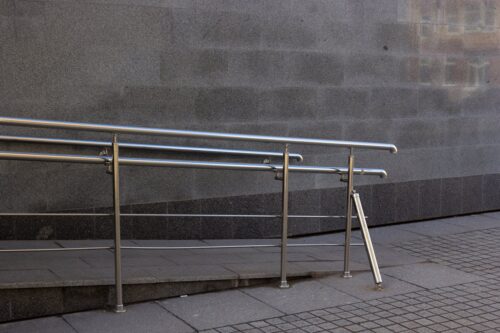Avoiding Slips with Proper Ramp Handrail Installation

In Ottawa, ensuring safety and accessibility in everyday spaces is crucial. One key element in creating secure pathways for individuals with mobility challenges is the installation of properly designed ramp handrails. These handrails do more than just provide balance; they act as a safety net, preventing slips and accidents, especially in environments prone to icy or wet conditions. Understanding the significance of these handrails becomes increasingly important.
Ottawa’s weather can be unpredictable, making safety precautions even more necessary for ramps. Spring showers or leftover winter ice can create slippery surfaces, posing risks for anyone using a ramp. Handrails serve a practical purpose by offering stability and support, ensuring those who rely on ramps for mobility can feel confident and secure. Let’s explore why handrails are essential for safety on ramps and how they perform a vital role beyond just being a structural feature.
The Role of Handrails in Preventing Slips
Handrails aren’t merely an accessory for ramps; they are an integral safety component. Imagine walking up an icy ramp without anything to hold onto. That feeling of uncertainty is why handrails matter so much. They provide the physical support needed to navigate these paths safely and offer reassurance to anyone who might feel hesitant.
1. Stability and Grip: Handrails provide a steady place to grip. Whether you’re young or elderly, firm support can make all the difference in maintaining balance.
2. Support in Wet Conditions: Ottawa experiences a fair share of rain and snow, making ramps slippery. Handrails act as a dependable aid during these wet, treacherous conditions.
3. Guidance and Security: They help guide users, giving them the confidence to use ramps freely without fear of slipping.
Particularly in locations like Ottawa, where the weather can fluctuate, the role of handrails becomes even more pronounced. They transform any ramp from a potentially hazardous area into a more secure and user-friendly path for everyone. With this simple addition, using ramps becomes not only safer but also more inclusive, accommodating the diverse needs of all users. By investing in sturdy, well-placed handrails, communities can make great strides in promoting accessibility and safety.
Key Features of Effective Ramp Handrails
To truly prevent slips, it’s important to consider the features that make a handrail effective. First up is grip design. A handrail should offer a secure grip, even in slick conditions. A handrail with a grooved or textured finish is ideal as it helps prevent hands from slipping, even when wet. Next, consider the height of the handrail. It should be conveniently positioned so both children and adults can easily reach it, providing support to the widest range of users.
Material choice is another key aspect. Handrails made from durable, weather-resistant materials can withstand the varied and sometimes harsh climate of Ottawa. Some materials offer better grip and warmth, helping prevent the cold shock of touching a metal rail in winter. Here’s a quick list of essential features to consider when choosing a handrail:
– Grip Design: Look for textured or grooved finishes.
– Height: Ensure accessibility for all users.
– Material Durability: Opt for weather-resistant, grip-friendly materials.
Selecting the right handrail involves balancing these features with the specific needs of the users and the conditions of the environment.
Installation Best Practices
Installing a handrail isn’t just about putting up some metal or wood. It requires thoughtful planning and precision. Start by securing the handrail firmly to the wall or post. A loose handrail negates its purpose entirely, so double-check attachments for sturdiness. Consider the slope of the ramp too. The handrail should run parallel to the ramp surface, maintaining a consistent height. A handrail set too high or too low can reduce its usability and safety.
It’s essential to follow local regulations regarding installation. These regulations often outline specific requirements for public safety, ensuring that the handrails provide the intended safety benefits. Non-compliance could not only lead to safety hazards but potentially invite penalties.
Proper installation techniques may include:
– Secure Attachment: Make sure the rail is firmly anchored.
– Positioning: Keep the rail at a consistent, accessible height.
– Regulatory Compliance: Adhere to safety and legal standards.
Getting these elements right during installation means the handrail will serve its purpose effectively and last for years.
Maintenance Tips for Long-Lasting Handrails
Once a handrail has been effectively installed, keeping it in top condition involves regular maintenance. Regular inspections are key. Look for any signs of wear or weakness in the structure. If the handrail wobbles or shows signs of rust, address these issues quickly to maintain safety standards.
Cleaning is also important. Dirt and debris can accumulate on textured surfaces, making them less effective over time. A simple wipe down with a non-abrasive cleaner can help preserve their gripping ability. Consider routine checks and cleaning schedules as part of regular property maintenance.
To prolong the life of your handrails, follow these tips:
– Routine Inspections: Check for signs of wear like rust or looseness.
– Clean Regularly: Keep surfaces free from dirt and grime.
– Timely Repairs: Fix issues promptly to prevent safety risks.
A focus on these maintenance practices ensures that handrails remain a reliable part of your accessibility solutions, contributing to a safer environment for everyone.
Stay Safe and Secure with Proper Ramp Handrails
Incorporating these practices into the design, installation, and maintenance of ramp handrails creates a more accessible and secure environment. Handrails play a pivotal role in enhancing safety for everyone who uses ramps, making them an indispensable feature for both residential and public spaces. Their presence reassures users and provides them the confidence to maneuver freely, regardless of the weather conditions.
Effective handrails are a blend of thoughtful design, precise installation, and consistent upkeep. When these elements come together, they not only enhance safety but also encourage a more inclusive approach to mobility solutions. By prioritizing quality and attention to detail, communities can ensure that their spaces are welcoming and accessible to all.
Whether you’re looking to enhance the safety of your private home or a commercial space, the importance of well-maintained handrails cannot be underestimated. Regional Ramp offers a variety of solutions tailored to meet the diverse needs of our clients. To learn more about the right ramp handrail for your needs or for expert assistance in choosing and installing one, reach out for reliable guidance.

